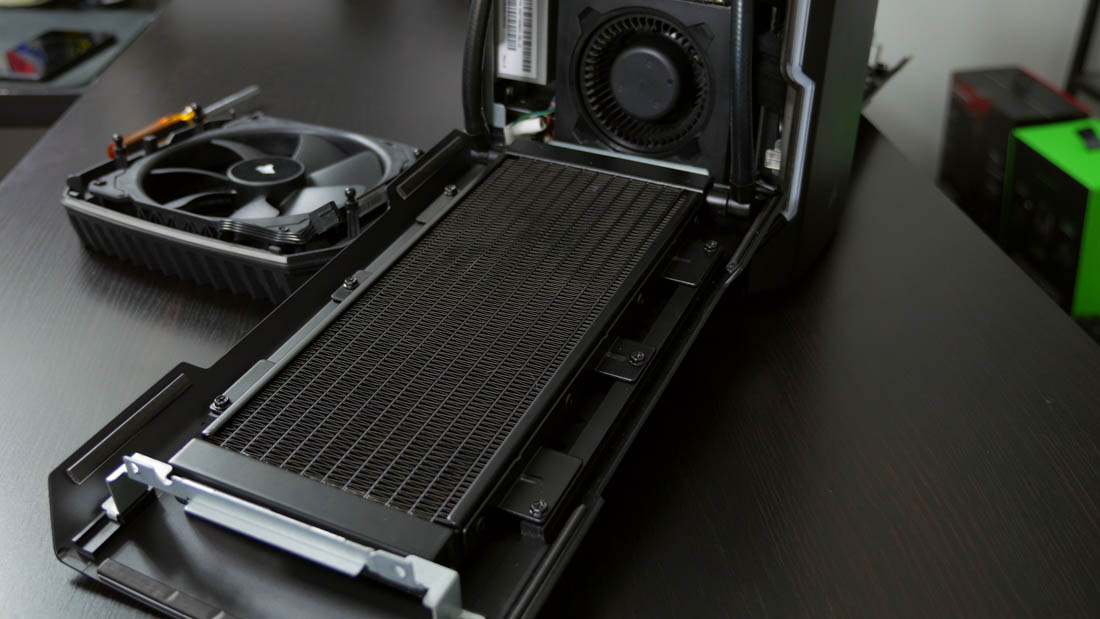Performance, Overclocking and Thermals
As before, the review unit I received came equipped with an Intel Core i7-7700K processor, an Nvidia GeForce GTX 1080 graphics card, 16GB of DDR4 2400 MHz memory, and a Corsair Force LE 960GB SATA SSD. Unfortunately, the Corsair One cannot accommodate an M.2 SSD, so you can't get PCIe storage speeds; you'll have to make do with SATA.
I'm not going to spend a ton of time talking about the performance of this system, because both the i7-7700K and GTX 1080 perform exactly as expected. If you want to know how either part performs, it's a good idea to check out our reviews of these components.
Our GTX 1080 review in particular covers the exact performance you can expect from the One, as our test bench also uses a Core i7-7700K (albeit overclocked for marginal performance gains).
I did play several games on the Corsair One, mostly on my 1080p TV (yes, I'm a pleb and haven't upgraded to a 4K TV yet). I managed to run Watch Dogs 2 at 1080p above-Ultra settings with 2xMSAA at 60 FPS or thereabouts, which was a fantastic experience. The Corsair One destroyed Mass Effect Andromeda at 1080p Ultra settings, pushing well into the 90 to 100 FPS range. This system could easily play Andromeda at 1440p with the same settings, or 4K at slightly reduced settings.
The cooling solution in the Corsair One is outstanding. At idle, the One is a quiet though not silent system; you'll hear the fans running if you place the system on your desk, but it's easy to drown it out with even a low-volume song or video.
But the One is most impressive under load. The system doesn't spin up its fans under the slightest pressure, so if you're only doing an intensive task for a few minutes, the One will stay near-silent. It takes about 10 to 15 minutes for the fans to kick into gear, and even then, the system isn't particularly loud. In-game audio at a comfortable volume on external speakers will easily drown out the mid-tone rumble of the fans; you won't have to put up with annoying high-pitched whining or a tiny and brutally loud cooler.
And I tested the Corsair One right next to a monitor on a desk as well. Place the One on the floor, or a bit further away, and the One becomes pretty darn quiet.
Thermals are well managed, too. During an hour-long session of Watch Dogs 2 (at Ultra quality settings of course), the i7-7700K sat in the 68°C to 72°C range, while the GTX 1080 flatlined at 54°C. CPU temperatures here are reasonable and about what you'd see from an air cooler in a traditional desktop. Although the CPU is liquid-cooled, you must remember the radiator has no fans near it, so it's relying entirely on the top fan to create enough airflow. GPU temperatures are outstanding, assisted by the nearby blower fan, so there's plenty of room for overclocking.
Under AIDA64's system stability test, the CPU sat at around 83°C, while the GPU still reached 54°C. This presents a worst-case scenario, and considering this CPU temperature, you probably won't want to push the CPU's clock speed too much. But this is a review after all, so I overclocked it to the maximum anyway.
I pushed the Corsair One's i7-7700K up to 4.8 GHz without issue, with the CPU sitting at 88°C under AIDA64's stability test. I did try the CPU at 4.9 GHz, but that pushed temperatures over 90°C, which is a bit too hot for my liking. Plus at 4.8 GHz you're getting a decent performance improvement anyway.
On the GPU side, before overclocking the Corsair One's GTX 1080 was hitting a boost clock of 1873 MHz in Watch Dogs 2, which is already decent for this graphics card. I was able to achieve a +190 MHz core clock boost and +160 MHz memory clock boost without much fuss, which sent the GTX 1080's core up to 2050 MHz during Watch Dogs 2. Squeezing an extra 11 percent more performance is always welcome, and I'm sure there's more headroom if I were to play around a bit more.
As for GPU temperatures while overclocked, there's so much GPU temperature headroom that the GTX 1080 sat at just 55°C under load. Yep, that's right, it was just 1°C hotter while overclocked. Chucking a GTX 1080 Ti in here on the same cooling solution should present no issues, even if overclocked, too.




